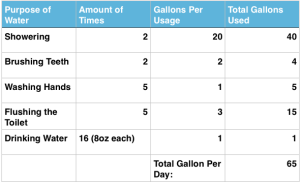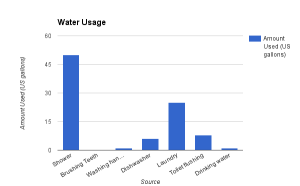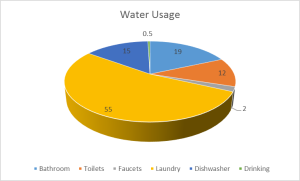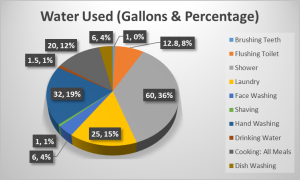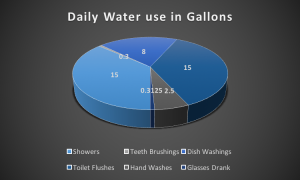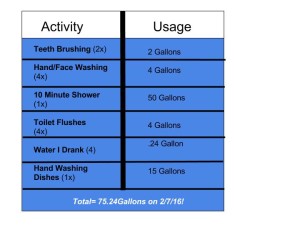Where I currently reside in rural western North Carolina outside of Asheville in the mountains everyone has well water. It is in a way being off the grid I think a good thing if you can obtain good clean fresh drinking water from a well. Septic systems especially older ones can present potential issues especially if not properly maintained. If the system is of a modern and current design with a nice leaching field there shouldn’t be any issues and the water eventually reclaimed or pumped out by a service vehicle whatever preferred. The cost of drilling a well and installing a septic system far outweighs paying a utility company or municipality a bill every month for the life of the property. I myself utilize the water provided for all things except for drinking. I purchase bottled water for drinking consumption. Reason being is that in this area of the country much of the water including municipal water is heavily laden with calcium and causes kidney stones.
Daily Water Use:
Shower 10 gallons
B/T .5 av
Commode 12 av
Wash Hands 1 av
Cooking 2 av
Drinking 2 av
Dishwasher 2 av
Clothes Washer 3 av
Total: 32.5 gallons
If given the situation of having to be limited to just 2 gallons of water per day I would plan accordingly and take the following actions. Water would be limited to drinking and cooking only. Water for hygiene would be obtained from stream water, river, lake, ocean, whatever available. In using a footprint to eliminate the potential issues would be just using the 2 gallons and doing the above. I don’t think there is anything impossible about this however it would compromise a persons hygiene and cleanliness after a period of time, no doubt about it. Speaking in comparison to 1-b this would be a drastic but not impossible change and after a period of time one would learn to improvise and do the best they can with what they have to work with. Geography matters in water use as it presents a wide and varying diversity of locations where water may be more plentiful and then lack of availability of issues and problems related to cost and health.


